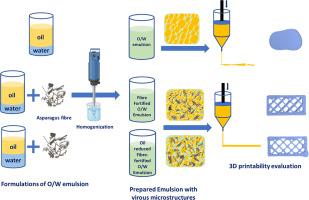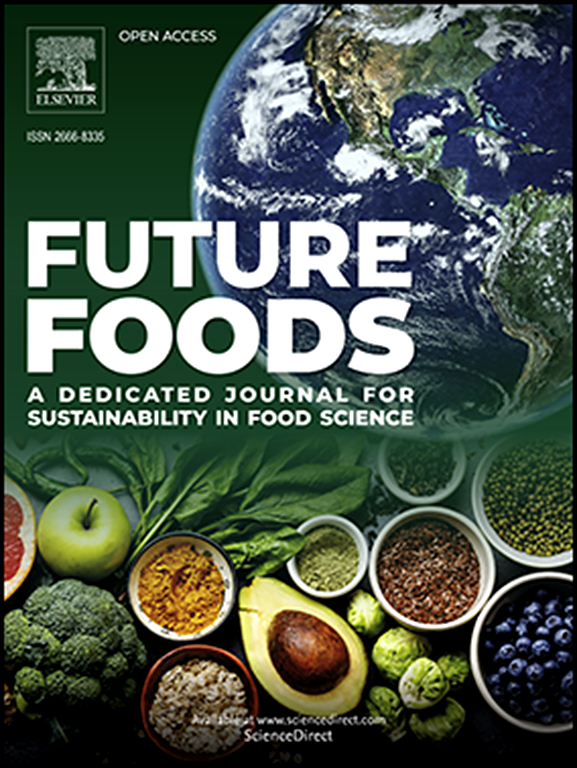Enhancing 3D printing performance of O/W emulsions with asparagus fibre
IF 7.2
Q1 FOOD SCIENCE & TECHNOLOGY
引用次数: 0
Abstract
Asparagus fibre recovered from agricultural waste stream can be valorised as a natural ingredient for fibre enrichment in food products. This study investigated the effects of asparagus fibre on the 3D printing performance of oil-in-water (O/W) emulsions as edible inks. Emulsion gels were prepared by either varying the fibre concentration in the aqueous phase or varying the volume fraction of the oil phase. Printability, rheological properties, and microstructure of the samples were systematically evaluated. Our results show increasing fibre concentration (up to 9.9 %w/w) significantly improved 3D printing performance of the inks, which was attributed to their enhanced rheological properties. Interestingly, reducing the oil volume fraction from 72 to 66 %v/v (i.e., fibre concentration was kept at 9.9 %w/w) did not detrimentally influence the 3D printing quality. Microstructural analysis of the emulsions revealed that increasing fibre concentration led to smaller size and different surface morphology of the oil droplets. Fibre particles in the aqueous phase may hinder oil droplet movement, stabilizing emulsions during 3D printing. Our findings give new insights into the development of edible 3D-printed food products via fibre enrichment and oil reduction.

用芦笋纤维提高水包油型乳液的 3D 打印性能
从农业废料流中回收的芦笋纤维可作为一种天然成分用于丰富食品中的纤维。本研究调查了芦笋纤维对作为食用油墨的水包油(O/W)乳液的三维打印性能的影响。通过改变水相中的纤维浓度或油相的体积分数来制备乳液凝胶。对样品的可印刷性、流变特性和微观结构进行了系统评估。我们的结果表明,增加纤维浓度(高达 9.9 %w/w)可显著提高油墨的三维打印性能,这归功于其流变特性的增强。有趣的是,将油的体积分数从 72%v/v 降低到 66%v/v(即纤维浓度保持在 9.9%w/w)并没有对 3D 打印质量产生不利影响。乳液的微观结构分析表明,纤维浓度的增加会导致油滴的尺寸变小,表面形态发生变化。水相中的纤维颗粒可能会阻碍油滴的移动,从而在 3D 打印过程中稳定乳剂。我们的研究结果为通过富集纤维和减少油分来开发可食用的 3D 打印食品提供了新的思路。
本文章由计算机程序翻译,如有差异,请以英文原文为准。
求助全文
约1分钟内获得全文
求助全文
来源期刊

Future Foods
Agricultural and Biological Sciences-Food Science
CiteScore
8.60
自引率
0.00%
发文量
97
审稿时长
15 weeks
期刊介绍:
Future Foods is a specialized journal that is dedicated to tackling the challenges posed by climate change and the need for sustainability in the realm of food production. The journal recognizes the imperative to transform current food manufacturing and consumption practices to meet the dietary needs of a burgeoning global population while simultaneously curbing environmental degradation.
The mission of Future Foods is to disseminate research that aligns with the goal of fostering the development of innovative technologies and alternative food sources to establish more sustainable food systems. The journal is committed to publishing high-quality, peer-reviewed articles that contribute to the advancement of sustainable food practices.
Abstracting and indexing:
Scopus
Directory of Open Access Journals (DOAJ)
Emerging Sources Citation Index (ESCI)
SCImago Journal Rank (SJR)
SNIP
 求助内容:
求助内容: 应助结果提醒方式:
应助结果提醒方式:


